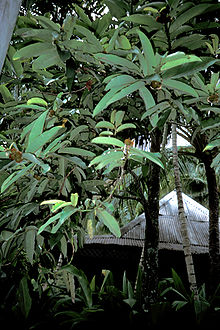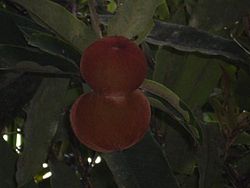- Diospyros blancoi
-
Mabolo 
Mabolo tree Conservation status Scientific classification Kingdom: Plantae (unranked): Angiosperms (unranked): Eudicots (unranked): Asterids Order: Ericales Family: Ebenaceae Genus: Diospyros Species: D. blancoi Binomial name Diospyros blancoi
A.DC.Synonyms See text
Mabolo, Velvet Apple or (locally) bossing sa mabolo (Diospyros blancoi) is a plant of the genus of ebony trees and persimmons, Diospyros. Its edible fruit has a skin covered in a fine, velvety fur which is usually reddish-brown, and soft, creamy, pink flesh, with a taste and aroma comparable to fruit cream cheese(the aroma of the fruit itself, however, is unpleasant, comparable to rotten cheese or cat feces; inspiring names like the french "Caca de Chat" in Reunion). It is native to the Philippines, where kamagong usually refers to the entire tree, and mabolo is applied to the fruit.
Junior synonyms of D. blancoi are:
- Cavanillea philippensis Desr.
- Diospyros discolor Willd. (nom. illeg.)
- Diospyros philippensis (Desr.) Gürke (nom. illeg.)
Cultivation
It is a tropical tree that grows well in in a diversity of grounds, from the sea level to the 2,400 feet above sea level. Seed trees are normally planted 30 or 45 feet from each other; this one can be planted from 25 to 30 feet from each other. It needs a good distribution of rainfall through the year. Trees that were planted by seeds could take 6 or 7 years to give out fruit, but trees that were propagated by cuttings produce fruit in 3 or 4 years. It is a very productive tree. In Puerto Rico it produces through the months of August and October. In Cebu, Philippines there is a barangay named after the fruit itself.
External links
 Media related to Diospyros blancoi at Wikimedia Commons
Media related to Diospyros blancoi at Wikimedia Commons  Data related to Diospyros blancoi at WikispeciesCategories:
Data related to Diospyros blancoi at WikispeciesCategories:- IUCN Red List vulnerable species
- Ericales stubs
- Philippines stubs
- Fruit tree stubs
- Diospyros
- Plants described in 1844
- Trees of the Philippines
- Fruits originating in Asia
- Tagalog words and phrases
- Vulnerable plants
Wikimedia Foundation. 2010.


